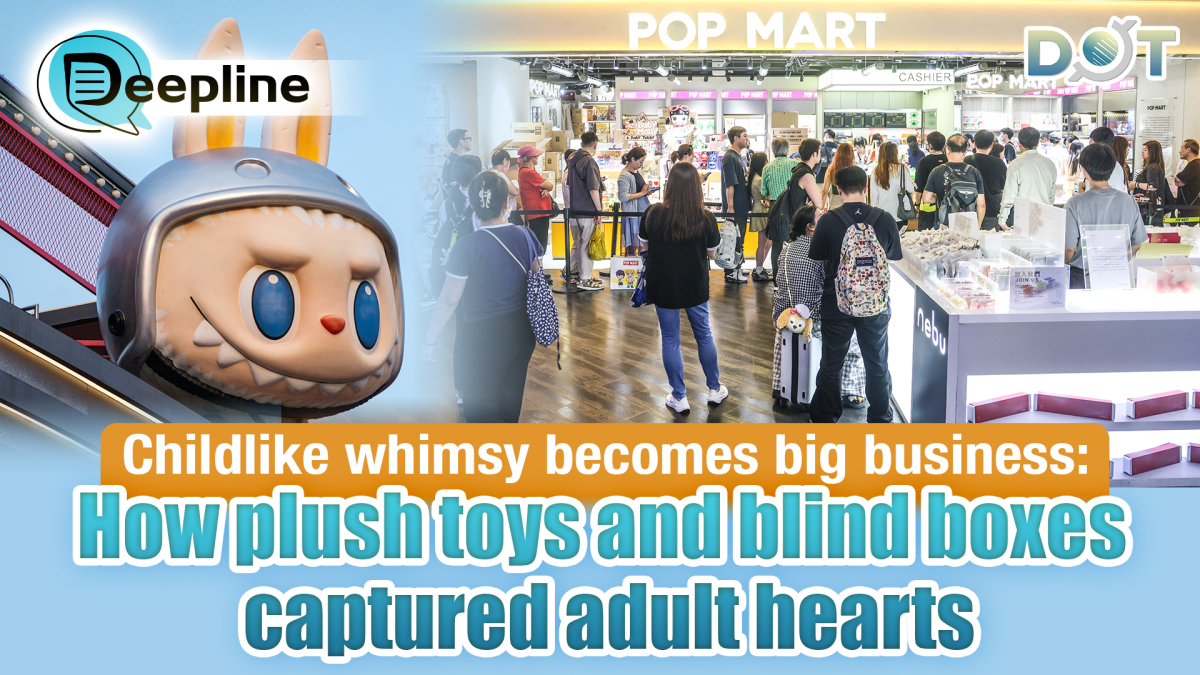
From children's playthings to urban adults' "favorite treasures," plush toys, collectible blind boxes, and plastic building blocks are not only filling emotional voids but also giving rise to a rapidly expanding "childlike whimsy economy." Driven by social media and e-commerce platforms, this market has reached tens of billions of yuan, with "whimsical consumption" permeating adult lives at an astonishing rate, becoming an undeniable new trend in the consumer market.
From Jellycat selling over a million Barcelona bears globally per year to Pop Mart's SpongeBob SquarePants-themed Labubu series selling out 10,000 units on Tmall in 3 seconds, and IP collaboration products frequently trending on social networks, this explosive consumption is quietly reshaping the lifestyles of contemporary young people.
"I say goodnight to my Labubu every night before bed; it's my most stable companion when I get home from work," said Xiaomin, a 34-year-old designer at an internet company. Over the past year, she has bought 23 different figurines and plush toys, spending an average of over RMB 1,200 per month. "I don't see them as just toys; they help me relax and make me feel like I still have a gentle side," she told reporters with a smile.
Naming Dolls, Checking In, and Flaunting "Personas" on Social Media
There are many adult consumers like Xiaomin. On social platforms, "plush toys for adults" has become a popular tag. Users proudly display their collections: walls of figurines, piles of plush toys, and arrays of blind boxes. Some even create short skits for their dolls or write backstories for them. "I named my Jellycat 'Flopsy'; it's a poet living by the windowsill," one netizen posted on social media, sharing how they pose their doll in different ways daily and take it on trips to various landmarks, always making sure to take check-in photos.
Behind these actions lies more than just playful amusement. An increasing number of young people are seeking a psychological "buffer" in their fast-paced, high-pressure urban lives. The soft, cute, and pure qualities embodied by whimsical items exactly construct a controllable, stable form of spiritual solace for them. The "2025 White Paper on the Development of China's Toy and Baby Products Industry" notes that whimsical consumption is no longer limited to children, extending from toddlers to young adults and even elderly consumers. This cross-age consumption pattern is building a diverse consumer "field." Zhongshang Industrial Research Institute predicts that China's IP toy market size will reach approximately RMB 91.1 billion by 2025.
Meanwhile, traditional non-IP toy retail sales are also growing steadily. Data from the aforementioned white paper shows that the total retail sales of trendy and collectible toys in China in 2024 were RMB 46.57 billion, with total retail sales of trendy and collectible toys and peripheral products reaching RMB 55.83 billion. These figures collectively indicate a comprehensive warming of demand for whimsical consumption.
Unlike toys purchased for young children, whimsical products for adults can be quite valuable, often selling for thousands of yuan. The more expensive the top-tier items, the more sought-after they become. On Tmall, for example, taking perennial best-selling plush toy brands Disney and Jellycat as examples, Disney's Linabell, ShellieMay, Gelatoni, and StellaLou four doll IPs are called the "Money-Sucking F4." In Jellycat's official flagship store's comprehensive recommendation list, the 1,999-yuan Jellycat comfort pillow and the 7,999-yuan extra-large sun toy both rank high. Pop Mart's Labubu series blind boxes continue to sell well, with their hidden edition blind boxes seeing premiums in the secondary market, which have once exceeded 20 times.
Premium Pricing Transformed into "Reasonable Premiums"
Behind this product's premium is adults' high recognition of emotional consumption and symbolic consumption. Unlike traditional children's toys, top-tier whimsical products often combine collectible value, emotional connection, and community identity attributes. Many consumers admit that purchasing these products is not just for play but stems from psychological motivations like "companionship," "a sense of achievement," and "scarce possession." Paying a premium has gradually shifted from "irrational consumption" to a "reasonable premium," widely accepted among young people.
Meanwhile, the premium mechanism has also led to a complete secondary market ecosystem. Some brands even introduce member lottery systems and limited-time, limited-quantity sales, further amplifying the premium space by "creating scarcity." This market logic of "hype leads to hot sales" has gradually elevated whimsical products beyond mere toys, turning them into consumer goods with financial attributes, reflecting the new generation of consumers' high regard for emotional value and symbolic identities.
Looking Ahead: Challenges and Transformations in the "Childlike Whimsy Economy"
Regarding the future challenges and transformations of the "childlike whimsy economy," Jiang Han, a senior researcher at Pangoal Institution, believes that although the childlike whimsy economy currently shows strong growth momentum, achieving a transformation from "nostalgia consumption" to "sustainable value" still requires joint efforts from all parties in the industry. "Enterprises must continuously innovate, developing products with both cultural connotations and practicality. They also need to strengthen brand building, improve product quality, and service levels to ensure long-term competitiveness," Jiang Han pointed out. Cross-border collaborations, online-offline integration, and personalized customization will become important directions, with the latter also serving as a breakthrough point for upgrades.
(Source: Ta Kung Pao | Reporter: Kong Wenqiong | English Editor: Liu Yu)
Related News:
Deepline | 'King of blind boxes' Wang Ning surpasses Jack Ma in net worth
Pop Mart's annual revenue may exceed RMB 30 bn: Mini LABUBU launches this week




















Comment